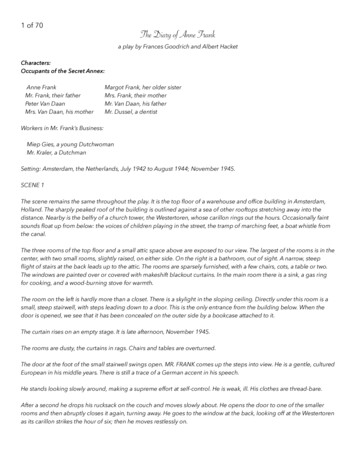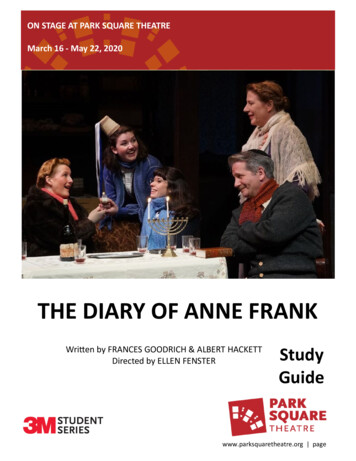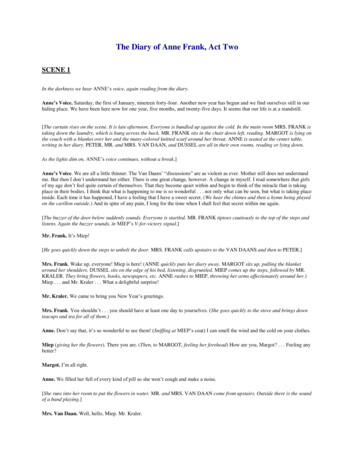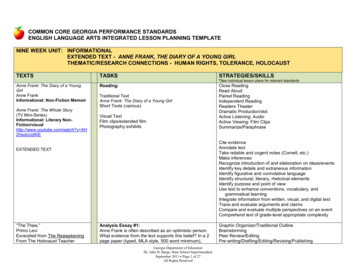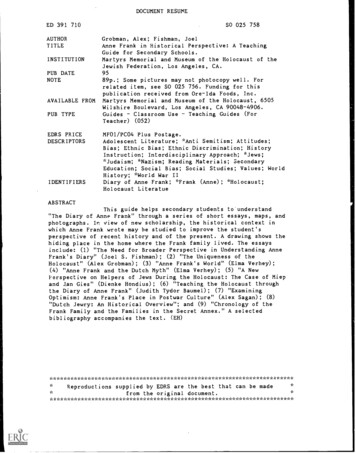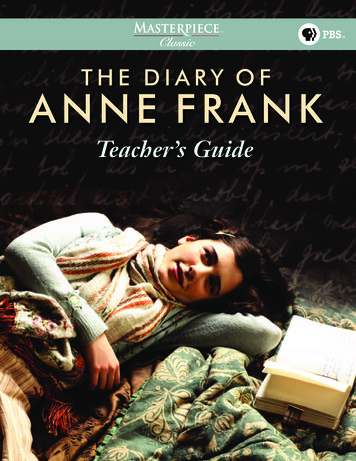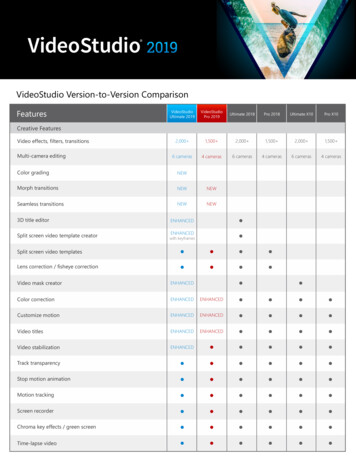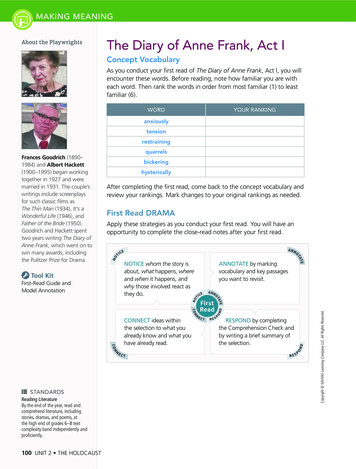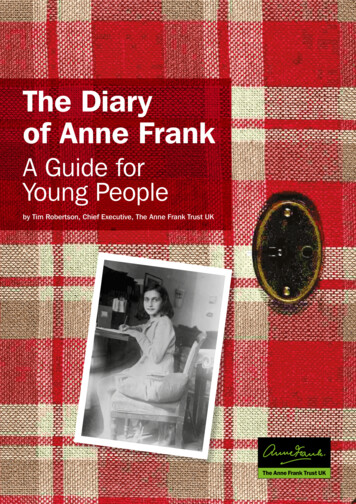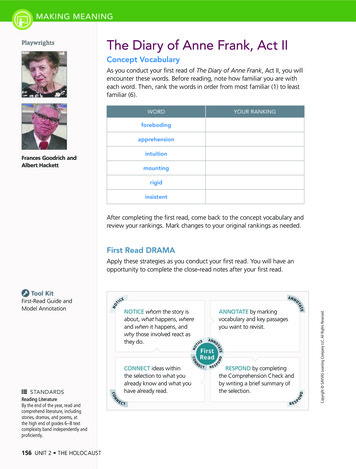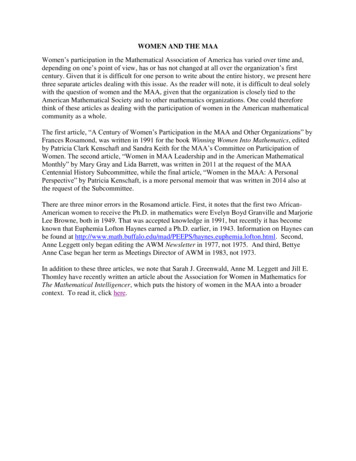
Transcription
WOMEN AND THE MAAWomen’s participation in the Mathematical Association of America has varied over time and,depending on one’s point of view, has or has not changed at all over the organization’s firstcentury. Given that it is difficult for one person to write about the entire history, we present herethree separate articles dealing with this issue. As the reader will note, it is difficult to deal solelywith the question of women and the MAA, given that the organization is closely tied to theAmerican Mathematical Society and to other mathematics organizations. One could thereforethink of these articles as dealing with the participation of women in the American mathematicalcommunity as a whole.The first article, “A Century of Women’s Participation in the MAA and Other Organizations” byFrances Rosamond, was written in 1991 for the book Winning Women Into Mathematics, editedby Patricia Clark Kenschaft and Sandra Keith for the MAA’s Committee on Participation ofWomen. The second article, “Women in MAA Leadership and in the American MathematicalMonthly” by Mary Gray and Lida Barrett, was written in 2011 at the request of the MAACentennial History Subcommittee, while the final article, “Women in the MAA: A PersonalPerspective” by Patricia Kenschaft, is a more personal memoir that was written in 2014 also atthe request of the Subcommittee.There are three minor errors in the Rosamond article. First, it notes that the first two AfricanAmerican women to receive the Ph.D. in mathematics were Evelyn Boyd Granville and MarjorieLee Browne, both in 1949. That was accepted knowledge in 1991, but recently it has becomeknown that Euphemia Lofton Haynes earned a Ph.D. earlier, in 1943. Information on Haynes canbe found at mia.lofton.html. Second,Anne Leggett only began editing the AWM Newsletter in 1977, not 1975. And third, BettyeAnne Case began her term as Meetings Director of AWM in 1983, not 1973.In addition to these three articles, we note that Sarah J. Greenwald, Anne M. Leggett and Jill E.Thomley have recently written an article about the Association for Women in Mathematics forThe Mathematical Intelligencer, which puts the history of women in the MAA into a broadercontext. To read it, click here.
Women in MAA Leadership and in the American Mathematical MonthlyLida K. Barrett and Mary W. GrayOften we are asked why there are not more women in leadership positions inmathematics. It may seem to some that there are so few women in the field that it is aquestion of supply. However, both historically and currently, the issue is not that simple,if by history we confine ourselves to the life of the Mathematical Association of America,founded in 1915. In the 1920’s it was less the case than now that to aspire to a leadershiprole one probably needed a Ph.D., but it was still an objective measure of the presence ofwomen in the field and indicated that there were many women available. In 1921, 40%(6 of 15) of the Ph.D.s in mathematics went to women, a figure that has not yet beenequaled. In the 1931-1935 period it was 15.7%. Then the figures declined even more,hitting a low of 4 to 5% in the late 50’s and early 60’s. The percentages began a slowincline upward after two events of 1972: Title VII of the Civil Rights Act of 1964became applicable to college faculty and the Association for Women in Mathematics wasfounded. AWM worked tirelessly to increase the participation of women in mathematicsand to improve the status of women in the field, and discrimination became illegal if notnonexistent. A figure of 34% of the Ph.D.’s in mathematics going to women was reachedin 1998-1999 and since then the percentage generally has hovered in the high twenties.Thus there has been little question of supply at the inception of the MAA or in recentyears.It is often remarked that when a minority reaches the level of 15% there is acritical mass, a mass that makes less exclusionary attitudes likely and leads to even moresubstantial representation of the minority. Although this benchmark was reached (for thesecond time after a decline of several decades) more than twenty years ago, thesubsequent pipeline effect has led only in isolated instances to substantial increases in theproportion of women in the leadership of top departments or professional organizations.It should be noted that the MAA has a better record (four women presidents in nearly 100years) than the AMS (two presidents in 130 years), but not nearly as good as the ASA,where four of the last seven presidents have been women for a total of twelve out of justover 100. All ten of the American women who received Ph.D.’s in the nineteenth centurywere active in the AMS soon after its founding in 1888, but the continuation ofparticipation or its spread to the MAA has been sporadic at best.That the mathematical sciences have been particularly inimical to women is easyto believe. However, prominent mathematicians have promoted the inclusion of womengoing back to the end of the nineteenth century. Gösta Mittag Leffler was responsible forgetting a professorship for Sonya Kovalevskaya at the University of Stockholm (it took100 years for there to be another women professor of mathematics there), Arthur Cayleywas noted for his advocacy on behalf of advanced education for women, G. H. Hardyreportedly found the implication of sexism in the questioning of Olga Taussky-Toddoffensive1, and David Hilbert is known (at least in legend) for declaring that Emmy1At her job interview for a position at Girton College, a member of the committee asked her, withmotivation we can imagine, "I see you have written several joint papers. Were you the senior or the junior1
Noether should not be excluded from the Göttingen University Senate on the basis of sexas it was, after all, not a bathhouse. True, envious male mathematicians have assertedthrough the ages that there were only two women mathematicians, one of whom(Kovalevskaia, whose work was said to be due to Weierstrass) was not a mathematicianand other one of whom (Noether, sometimes referred to as “Der Noether” or the “fatherof algebra” in not necessarily flattering ways) was not a woman. That the Christian mobsof Alexandria slaughtered Hypatia probably is not, however, primarily attributable toeither her sex or her mathematics. Much more recently, however, a well-knownmathematician, former president of both the AMS and the MAA, asserted that at hisprominent institution they once hired a woman for the math faculty but she was not reallyvery good so that they did not hire more women. He also had earlier remarked that thewomen Ph.D.’s trained at his department were not destined for the faculty of researchuniversities. On the other hand, such mathematicians as I. N. Herstein, Lipman Bers, andGail S. Young, Jr. were well known for their encouragement of women.However, we were charged with examining the role of women in the MAA.The part played by women in leadership in the MAA over the last fifty years can bediscerned by a look at the offices held by women at the national level. The list of nationalofficers and Section Governors appeared in the Monthly on a more or less regular basisuntil 1983. Going back to MAA’s tenth year in a special issue of the Monthly inNovember of 1924 there is a list of all the officers back until 1917; in each year there areone or two woman listed as elected members of the Council. In the 1927 listing Clara E.Smith of Wellesley College is listed as a Vice President. There are five women listed assection officers. This pattern more or less can be seen to have continued in the lists thatare available.Using the list of officers, the Board of Governors, and committees that appearedin the Monthly from 1960, fifty-five years ago, to 1983, when the list of officers andcommittees no longer appeared in the Monthly, we can see the pattern over this time.In 1960 there were no women national officers. In the 27 sections, Jewel Busheyas Governor of the Metropolitan New York section was the only woman Governor.There were 24 committees and women served on just two, those related to secondaryschools-lecturers, and contests. In 1961, there were two female section governors. In1963 the second vice president was Mina Rees who in 1964 received the firstDistinguished Service Award.Throughout the rest of the 1960’s there were one or more woman serving assection Governors and three to five on committees. In 1972 Dorothy Bernstein served asFirst Vice President; there was one woman on the Board of Governors; and there werewomen serving on twelve of the twenty nine committees of the Association.In 1973 June Wood was the Second Vice President and in 1975 Betty Hinmanwas Second Vice President. In 1975 women served on twelve committees; sometimes aauthor?" G.H. Hardy, also on the committee, immediately interjected, "That is a most improper question.Do not answer it!"2
woman served on more than one committee. In addition five women served on the Boardof Governors.In an email, David Roselle, who served as secretary beginning in 1975, said, “I donot think of myself as a good source of information about women and the MAA. TheMAA became a better organization as a result of there being additional women in theprofession. What I will say is that women were welcomed by the MAA and that I do notrecall any reluctance to appoint women to committees, as Executive Director, invitedspeakers, authors, editors, etc. In brief, things related to women were as things related towomen (and all others) should be.”The pattern of women’s participation as one of the officers and on the Board ofGovernors continued. In 1982 there were 26 women as members of committees. MarciaSward became Associate Director of MAA. By 1984, the last time the Officers andCommittee Members were listed in the Monthly there were twelve women on the Boardof Governors; there were 32 committees and, counting the women on subcommittees,thirty places were held by women.The participation of women continued to grow as the size of MAA continued togrow. Dorothy Bernstein became President elect in 1978 and served 1979 and 1980.Lida K. Barrett was President in 1989 and 1990, followed by Deborah Haimo in 1991and 1992. The secretary’s report in August 1999 reports the election of Ann Watkins,who served as President in 2001 and 2002, with Barbara Osofsky serving as First VicePresident and Tina Straley being appointed as the new Executive Director succeedingMarcia Sward, women in three key leadership roles.The appendix is a chart, a record kept by the MAA office, which details theparticipation of women in MAA over the period from 1998 to 2009.The history of the MAA is closely linked with that of the American MathematicalMonthly, so it seemed appropriate to look at the role of women in the Monthly. At thebeginning, it was customary to list most given names with initials only, so it is difficult toknow how many women can be numbered among the founders and early members.However, there seem to be exceptions to this custom, interestingly nearly all of whichappear to be names which are generally identifiable as those of women. Thus it wouldprobably be possible to put a lower limit of the number of women in the earlymembership lists, but not an upper limit. For what it is worth, we can note that the list of104 at the founding meeting includes nine with names superficially identifiable as female[19]. What is more interesting it that virtually all of these women are high schoolteachers, graduate students, or faculty at small colleges, mostly colleges for women only.Of the four officers and twelve Council members chosen, none is identifiably a woman,but there was one woman selected for the twelve-member committee on publications.The absence of women in more prestigious positions cannot, of course, be blamed solelyon the MAA itself. However, when the first president asserted in his “Tentative Platformof the Association” that “No man can speak with authority concerning the future of thisAssociation,” it is unlikely that he intended that a woman should, as he later stated “Thechief motive may well be said to be that of service to the whole body of teachers of3
mathematics in American colleges. If I am right, the Association will not stop atanything which will serve this body of men.” However, it was said that 125 of the 500“charter members” were women. Progress was slow; a 1953 list of sectional governorshas no women.What then of the Monthly? The language used by writers is instructive Oftenthere is an effort at inclusiveness as the recruitment of “men and women” to the study ofmathematics or the activities of the Association is noted. On the other had, any time thetopic turns to research, the attempt at inclusiveness fails. In fact, in the early days of theorganization it appears that the term “researcher” was unknown; instead we see repeatedreferences to the “man of research.”Bias in language also had a habit of showing up in problems as late as the onerelegating women and dogs to the same status in 1962: In how many ways can a party ofm men, w women, and d dogs be arranged in a row so that neither two women nor twodogs are together? Of course, perhaps that was a long-standing holdover from pre-MAAdays of the Monthly (1902) when a typical problem had women going to market to selltheir eggs. Eventually increased sensibilities led to an article entitled “Non-SexistSolution of the Ménage Problem” [4]. We also hear in 1977 of a talk, “Choosing aWife,” at an MAA meeting by Leonard Gillman, the declared reason for which was notonly to present some interesting mathematical reasoning, but to make a mathematicalcontribution in support of equal status for women, obviously perceived to be necessary.The talk was based on earlier Monthly articles and was followed by one by David Galeand Marilda Sotomayor (described as his mathematical grandchild) demonstrating that“Machiavellian” behavior in a matchmaking game could benefit women [11]. Althoughthrough the years there have been relatively few articles by women, we do see womenproposing solutions to problems and very rarely as speakers at meetings or as officers ofregional groups early on in the MAA’s operation of the journal.A 2001 Monthly article “Towering Figures in American Mathematics, 18901950” contains little about women, mentioning two students: Lucille Smith, noted as“later Mrs. G.T. Whyburn” and the distinguished mathematician Mary Ellen Rudin, whoobtained her doctorate with R.L. Moore at the end of the period of review (at least notdescribed as the wife of Walter Rudin) [39]. There is a reference to Mina Rees, certainlya major figure in American mathematics, if not “towering,” but she commands only apassing reference to her own Monthly paper [36]. The influx of émigrés is described asthe most dramatic development of the 1930s but Emmy Noether doesn’t rate a mention.The next year Mina Rees’s key role in funding mathematical sciences and in thedevelopment of computer science in universities deserved an article [38]. Amy ShellGellasch notes that Columbia did not welcome female doctoral students and Rees laterobtained her Ph.D. at Chicago, a major producer of women Ph.D.’s in the pre-World WarII period (largely Leonard Dickson’s influence), if not a place for women to obtainfaculty positions. Rees, like most others, graced the faculty of a women’s college,Hunter, before taking up the position with the wartime Applied Mathematics Panel thatled to her later enormous influence; interestingly she attributed her AMP appointment to4
her acquaintance with Courant and his reliance on the “buddy” system. Rees’ assistanceto young researchers included support of Mary Cartwright and Olga Tausky Todd. Reeswas a long-time activist in the MAA and AMS, receiving MAA’s first Award forDistinguished Service to Mathematics. AMS and IMS also honored her. She was thefirst female president of the AAAS, but was never in a leadership role in the mathematicsorganizations.Sophie Germain appears in the Monthly through a review by Joseph Dauben ofSophie Germain: An Essay in the History of the Theory of Elasticity by Bucciarelli andDworsky [7]. The authors and the reviewer both consider Germain’s mathematicsdisappointing, but attribute this to her lack of a sound mathematical foundation on whichto build her work, especially that in elasticity, and limited interaction with the activecontemporary mathematical community. Brief mention is made by the reviewer of thework for which she is best known, partial results on Fermat’s Last Theorem.There is a review [1] of Ann Hibner Koblitz’s biography in which the reviewerpays tribute to Kovalevskaia as “the author of influential papers [who] was respected bythe mathematical community for mathematical abilities beyond those reflected in herresearch.” An earlier article [34] emphasizes later work by other mathematiciansbuilding on that of Kovalevskaia but rather cavalierly dismisses the contemporarycriticism of her early work, particularly that leading to the Bordin Prize.Lenore Blum’s review of Constance Reid’s Julia: A Life in Mathematicscharacterizes the 1970’s as a time of consciousness raising for women in mathematicsafter the naiveté, denial and lying low of the 1960’s, concluding that subsequentlywomen mathematicians have proactively developed constructive programs to increase theparticipation of women in mathematics [5]. With that came honoring of the two womenin the derogatory quotation, Emmy Noether and Sonya Kovalevskaia, in variouscommemoratory ways. Also in 1996 the AWM held the Julia Robinson Celebration ofWomen in mathematics and subsequently the book, a compilation of four articles onRobinson’s life and work, in particularly the evolution of the solution to Hilbert’s tenthproblem, appeared.Blum also relates the following quotation from Julia of Robinson’s election to theNAS:“When the University press office received the news, someone there called themathematics department to find out just who Julia Robinson was. ‘Why, that’sProfessor Robinson’s wife.’ ‘Well,’ replied the caller, ‘Professor Robinson’s wifehas just been elected to the National Academy of Sciences.’”Robinson’s health would not accommodate a full time teaching load and the Berkeleydepartment had never before seen fit to offer her a real part-time position. The same yearas her election, the math department decided to give her a full professorship (with theduty of teaching one-fourth time. Julia was the first female president of the AMS (19831984) (Cathleen Morawetz being the second and last (1995-1996)).5
But sometimes when women mathematicians write in the Monthly, there is littleevidence of sisterly appreciation of others’ work. Cathleen Morawetz, reported in“Giants,” [32] on the progress and changes in applied mathematics from the founding ofthe MAA until 1990. Outside of a vague mention of a nameless daughter of GeorgeBoole and aunt of Geoffrey Ingram Taylor, a pioneer in the study of turbulence (Taylor isone of Morawetz’s “giants”), we hear little of women. The author’s references to herown career do note her inability to lunch in Cambridge Commons or enroll in Caltech,but hint at the advantages of the paternalistic buddy system. One is tempted to ask: willsubsequent women mathematicians name earlier women as their “giants.” Indeed, forBlum, Robinson was a “giant.”In its earliest years, the Monthly addressed the issue of women’s mathematicaleducation head-on. In 1917 we find a discussion “Relating to Required Mathematics forWomen Students,” one of the rare articles written by women in those years [26]. Theargument is made that “some college mathematics” is needed if a woman student “is tohave an education that will send her out into life with the best general equipment.” Thecollege mathematics thought to be essential is college algebra and trigonometry,distinction being made between the routine of high school algebra and the logic andreasoning involved in college algebra courses, bolstered by the contention thatmathematics—unlike economics or philosophy—furnishes the woman student with asubject in which the validity of the conclusions drawn from its laws can easily be tested,and in which “the personality of the instructor and the bias of the student can play nopart.” Apparently this is proposed as necessary because of the fact that “the woman isprone to look at everything from the personal side.” The article continues to remark uponthe trend towards requiring science courses of women and the fear that removal of amathematics requirement will push them towards “non-mathematical sciences (if suchsciences truly exist) These fields may be wide and they may be fertile, but bypermitting this limitation women are denying to themselves the equality of opportunitywith men that has been won for them at such a cost by the pioneers in the struggle for theright of women to share in the higher education.” Whether mathematics should berequired of everyone (man or woman) and what mathematics should it be continue to bethe subject of discussion a century later in the MAA and elsewhere, but so also does whatequality of opportunity should mean and how should it be assured.A 2001 article [17] recounted the role of mathematics in World War I, includingthat of Elizabeth Webb Wilson, a “computer” before there were computers, whoconstructed a new range table for field artillery at the office of mathematical ballistics,where she worked with seven other women computers. In a bow to equal opportunity,the 1924 report on research fellowships in mathematics recently funded by theRockefeller Foundation described one purpose as “the opportunity for more thoroughtraining of young men and women in research.” However, the fundamental requirementsof an applicant were said to include “promise for the future backed by the opinions ofmen closely associated with him in scientific work” [27].6
With U.S. entry into World War II only months off, “On Education for Service”made eloquent appeals for more extensive mathematical training for men and women,foreshadowing the significant role to be played by women, especially as “computers” byasserting “In particular, it would be desirable to have numerous women trained throughthe stage of elementary mathematical statistics, for the use of government, theprofessions, and industry.” Other recommendations include training for inductees intothe armed services in eighth and ninth grade “modern” mathematics and the study by“each boy and girl of sufficient mathematical aptitude” of solid geometry and sphericaltrigonometry as a patriotic action. [18] However, in 1943 another article on mathematicsin wartime mentioned that five institutions provided special courses involvingmathematics for the training of women, but could cite only one success story, a womanwho, “with an A.B. degree in mathematics (Phi Beta Kappa key!) obtained an attractiveposition in the Research Laboratory of the United Aircraft Corporation at East Hartford,Connecticut.” Apparently the Monthly editors failed to see how ridiculous this statementappeared. [33].Some thirty years after the pleas of 1917, perhaps as a result of the call forpatriotism cited above, the Women’s Bureau of the U.S. Department of Labor produced,as part of a series of opportunities for women, a booklet on the outlook for women inmathematics and statistics [28]. More than a prospective look, the booklet provided astudy of what women had been doing during World War II. The Monthly review notesthat the booklet might be a useful guide for all seeking to earn a living by following somemathematical profession, but did not foresee how the propaganda to keep women out ofthe paid work force would mean that few women might be among the successful jobseekers in the coming years. Similar booklets were produced in 1956 and 1957 [13].On the other hand, the 1946 “Rehabilitation of Graduate Work” [20] speaks of theneed to continue the research done by men and proposes the creation of “as many as 6000four-year scholarships to enable young men who show scientific promise to work for thebachelor’s degree.” The article concludes by calling on the MAA to meet the challengeof “widening the frontiers of mathematical truth,” but apparently not for women.The famous Gardner report of 1956, “A National Weakness” [12] refersrepeatedly to the need for better mathematics education for all youngsters but then opines“The national need for men [emphasis added] with scientific and mathematicalcompetence exists at all levels. It is not just that we need more creative scientists at theNobel Prize level. Behind the great creative minds in science moves an army of able andsuperbly trained men who test and confirm (or reject) new discoveries .” When hereaches the level of well-trained and skillful laboratory technicians and assistants, thegender-specific language disappears.The result of the change in societal norms immediately after World War II wasreflected in an article the next time the question of women and mathematics appeared inthe Monthly, at the half way point between the period of the discussion of 1917 and thepresent but after more than a decade of women retreating from the work force. Manyreached the conclusion that women were needed back in the paid work force if the7
education situation cited by Gardner was to improve. In a brief new item we learn of aprogram at Rutgers for the “Re-Training in Mathematics of College Graduate Women”[29]. Funded as a pilot program by the Ford Foundation, the “program was set up inrecognition of the fact that college graduate women who wish to start or resumeprofessional work after years of raising a family need guidance and re-training” andrecognizing that relearning old or learning new mathematics is essential to the process.Several years later the Monthly reported [25] that 188 women and 2 men had successfullycompleted one or more semesters of the program. As the program was motivated by theshortage of qualified mathematics teachers, not surprisingly the majority of thosecompleting an entire program were teaching. Nearly half a century later we still have thisshortage although among the many programs designed to address the issue there may notbe any exactly like that of Rutgers in the 60’s. Should there be? Is the situation sodifferent now than it was then?What has changed in the last forty years is the percentage of degrees inmathematics at each level going to women. In 1961 [22] it is reported that 28.9% ofbachelor’s, 18.8 % of master’s and 5.3% of Ph.D.’s in mathematics and statistics wereawarded to women, a result much worse than the figures for Ph.D’s in either 1930 or2009; as noted above, in 1921 the percentage of women among those getting Ph.D’s was40% (admittedly that amounted to only 6), but in the period 1931-1935, the percentagewas 15.7% (63 women) [21]. W.L. Duren, in a article recounting his experience as agraduate student at Chicago in the 1920’s [9], says “Only years later did I learn that itwas considered unladylike to study mathematics I wonder if the current women’sliberation has even yet succeeded in pushing the professional status of women to the levelalready reached in the twenties.” Note that the wide presence of women with Ph.D.’swas not reflected on the faculty of research institutions either then or now.The employment of women mathematicians is a phenomenon little commentedupon in the Monthly. It is clear that the healthy production of women Ph.D.’s in the 20’sand 30’s did not result in very many women being hired on the faculties of majoruniversities; those who were employed in higher education were generally at women’scolleges. However, gradually such colleges, for whatever reason, began to employ moremen, eliminating jobs for women as faculty and as role models for women students,without a concomitant rise in the percentage of women on the faculties at men’s collegesor at integrated institutions. The conversion of many women’s colleges to co-edinstitutions may well have contributed to fewer jobs for women and to fewer womeninspired to go to graduate school in mathematics. Even today the production of womenPh.D’s exceeds their intake on the faculties of top research institutions. Currentlyannually statistics are gathered under the auspices of MAA and other mathematical andstatistical organizations but are generally published in detail only in the Notices of theAmerican Mathematical Society.In 1961, an article by the distinguished mathematician and administrator MinaRees reported on the topic she knew so well, “Support of Higher Education by theFederal Government” [35]. In discussing where the personnel will be found for themathematical tasks foreseen, she asks “What of women?” After admitting that8
“historically, women have characteristically not been productive mathematicians Inteaching, however, and in many phases of applied mathematics that are now claiminglarge numbers of our trained youth, women have performed most effectively.” Shecontinues with a rather negative assessment of the potential of women in mathematics,but doesn’t address the always interesting issue of whether women are more attracted tosome fields than others. For example, the percentage of Ph.D’s in statistics going towomen is close to 50%, far higher than in other sub-disciplines in the mathematicalsciences.Serious, more sustained attention to the issue of women in mathematics waskicked off with an article with that title (authored by one of the current authors) [15].The subject of “Women in Mathematics” was primarily to report on a panel at the 1971Summer MAA meeting. Topics included the contemporary paucity of women onmathematics faculties at research institutions, the existence of women mathematicians inthe past, the effect of cultural conditioning, and finally proposed efforts to increase theparticipation of women in mathematics as well as their status within the profession.Remedies that
The Mathematical Intelligencer, which puts the history of women in the MAA into a broader context. To read it, click . here. 1 . Women in MAA Leadership and in the American Mathematical Monthly Lida K. Barrett and Mary W. Gray . Often we are aske
